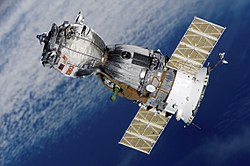| COSPAR ID | 1989-071A |
|---|---|
| SATCAT no. | 20218 |
| Mission duration | 166 days, 6 hours, 58 minutes, 15 seconds |
| Orbits completed | ~2,680 |
| Spacecraft properties | |
| Spacecraft | Soyuz 7K-STM No. 58 |
| Spacecraft type | Soyuz-TM |
| Manufacturer | NPO Energia |
| Launch mass | 7,150 kilograms (15,760 lb) |
| Crew | |
| Crew size | 2 |
| Members | Aleksandr Viktorenko Aleksandr Serebrov |
| Callsign | Ви́тязь (Vityaz - Knight) |
| Start of mission | |
| Launch date | 5 September 1989, 21:38:03 UTC |
| Rocket | Soyuz-U2 |
| End of mission | |
| Landing date | 19 February 1990, 04:36:18 UTC |
| Landing site | 55 kilometres (34 mi) NE of Arkalyk [1] |
| Orbital parameters | |
| Reference system | Geocentric |
| Regime | Low Earth |
| Perigee altitude | 390 kilometres (240 mi) |
| Apogee altitude | 392 kilometres (244 mi) |
| Inclination | 51.6 degrees |
| Period | 92.4 minutes |
| Docking with Mir | |
| Docking date | 7 September 1989, 22:25:26: UTC |
| Undocking date | 19 February 1990, 01:06:20 UTC |
 Soyuz programme (Crewed missions) | |
Soyuz TM-8 was a 1989 spaceflight which carried the fifth long duration crew to the Soviet space station Mir. [2] It was part of the Soyuz-TM series of spacecraft, which were the fourth generation of the Soviet Soyuz. Soyuz TM-8 was the eighth crewed spaceflight to Mir, and spent 166 days in orbit.

